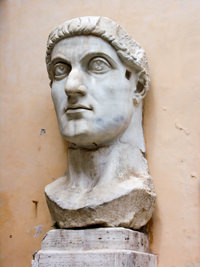
DAVID ADAMS takes a look at the life Constantine the Great, an instrumental figure in the development of the early church and the relationship between church and state…
Known as the Roman Emperor who made Christianity a state religion, Constantine – awarded the title ‘the Great’ (and that of Saint) – played a key role in shaping the early church, the ramifications of which we still grapple with today.
Born in the Balkans some time between 274 and 288 AD, Constantine was the son of a rising Roman officer Constantius and his wife Helena. His father was elevated to the rank of Caesar of the West (a “deputy emperor”) in 293, after which Constantine was sent east and attended the court of the Emperors Diocletian.
 |
|
Statue of Constantine the Great, Musée du Capitole, Rome PICTURE: I, Jean-Christophe BENOIST/Wikipedia. |
In 305, after his father was raised to rank of Augustus, the senior Emperor of the West, Constantine was recalled to the west where he joined his father on campaign in the western-most province of Britannia (Britain). His father died in 306 while still on campaign and so it was in the Roman town of Eboracum (now York) that Constantine was proclaimed Emperor of the West by the army.
There remained unrest across the empire, however, and Constantine was soon embroiled in a series of civil wars against rival emperors Maxentius and Licinius which didn’t end until their final defeat in 324 when Constantine became the sole emperor of both the eastern and western empires.
As emperor, Constantine is noted for the many reforms he introduced in a range of spheres – restructuring the government and separating military and civilian authorities, introducing the new gold solidus which become the standard currency for more than 1000 years, carrying out building projects including a lavish new palace at the former eastern imperial capital of Byzantium which he renamed Constantinople (now Istanbul) after himself, and, of course, most famously, playing an instrumental role in the spread of Christianity.
There’s some debate over when Constantine became a Christian – some suggest it was as a child, thanks to the faith of his mother (St) Helena while others propose it was a more gradual awakening over the course of his life (and others still claim that he only adopted Christianity for political purposes).
Throughout his military career, Constantine attributed his success to his Christian faith, most famously his victory at the Battle of the Milvian Bridge near Rome against the forces of Emperor Maxentius in 312. The night before the battle, Constantine claimed to have had a vision in which he was instructed to have his men paint the Christian symbol, the Chi-Rho, on their shields in a sign that they were to fight under Christ (other versions have him seeing a cross in the sky with words that through that sign he would conquer).
Constantine was also known to have promoted tolerance of Christianity within the empire – in 313 AD, he met with then Emperor Licinius in Milan and together they pushed for the toleration of Christianity within the empire (although there is some debate over whether a formal edict to this effect – the “Edict of Milan” – was ever published).
During his reign, he continued to support Christians – returning previously confiscated property, promoting them to high offices and granting privileges, such as exemption from taxes, to the clergy. He is also noted for the donating funds for the construction of church buildings, the most famous of which are the Church of the Holy Sepulchre in Jerusalem and now long-gone old St Peter’s Basilica in Rome.
And, of course, he was a driving force behind the famous first Council of Nicaea, summoning church leaders from across the known world in 325 to settle key matters then dividing Christianity including the nature of Jesus, a decision on uniform acceptance of the date of Easter, the introduction of various rules governing churches and the writing of the first part of the Nicene Creed.
Constantine’s personal life, meanwhile, wasn’t above controversy – he apparently executed both his eldest son (and deputy emperor) Crispus (son of his first wife Minervina) and his wife, the Empress Fausta. While motive for the executions remain uncertain, it was suggested Fausta and Crispus might have had an illicit relationship.
In the early 330s, Constantine spent time in successful campaigns against the Goths and the Sarmatians and he was prepared to campaign against the Persians when, in 337, he became sick. Having been baptized on his deathbed, he died in Nicomedia near Constantinople on 22nd May, 337 AD. He was buried at the Church of the Holy Apostles in his capital and succeeded by his three sons, Constantine II, Constantius II and Constans.
The second longest serving emperor in Roman history and regarded by many as the founder of the Byzantine Empire, Constantine was instrumental in taking Christianity from being a sect whose believers practised in private to a public, state-supported church. His impact on the world and the Christian faith specifically, both during his life and even now, more than 1,600 years after his death, cannot be disputed.
SOURCES AND FURTHER INFORMATION:
‘Constantine the Great’, Catholic Encyclopaedia New Advent
J F Matthews and Donald MacGillivray Nicol, ‘Constantine I’, Encyclopaedia Britannica
‘Constantine the Great’, Wikipedia
Robert Arakaki, ‘Constantine The Great: Roman Emperor, Christian Saint, History’s Turning Point‘, Antiochian Orthodox Christian Archdiocese of North America
‘Constantine I’, Biography.com





